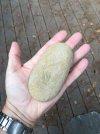- Joined
- Apr 18, 2021
- Messages
- 292
I can get a sandstone (arenite) for less than $9 (shipping included), but my guts are saying that's a very bad deal. Too coarse, too soft... Not useless, of course, but adds nothing to the tools I already have.
https://zebu.com.br/produto/pedra-de-afiar-e-amolar/
I'm open to experiment with new toys, but... apart from that, is there any reason to get this stone?
https://zebu.com.br/produto/pedra-de-afiar-e-amolar/
I'm open to experiment with new toys, but... apart from that, is there any reason to get this stone?
Last edited:


